Pulau Pulau Tiduk
The Nias Channel Crossing
The Island of Nias got smaller and smaller until it finally sank beneath the waves in the horizon. The seas were rough and the clouds threatened a down pour but soon cleared and the sun shone down on us as we lay accross the front deck.

We dozed off and awoke to the smell of Mahi Mahi and our bellies began to rumble. We asked the boats cook for some hot water and selected two feral meals (freeze-dried backpacker food), beef patties with mash potatoes being the prime choice. The smokey beef patties were a little taste of heaven, a reminder of the comforts of home.

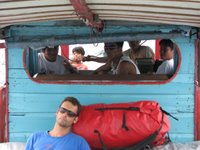



After roughly 5 hours at sea, the sun began to fade and we got our first glance of the Tiduk Archipelago far in the horizon. Garbage began to appear in the water and we knew that we were close to Indonesian civilization.

A pod of dolphins appeared and playfully swam in the wake of our boat. As we approached the first island with the last trace of light, we could make out a small but nice left breaking off a forest covered point, locals fishing the inner lagoon in their small canoes.


We pulled into Tiduk Island, the administrative island of the archipelago, under a sheet of darkness. In the Tiduk town harbor we docked against another fishing vessel and carried our luggage over three boats before we reached solid ground. Lucky for us, our hotel was right there; we threw our stuff in the room and headed out to get some food.
One of the only 3 cars on Tiduk Island.

Tiduk Town was like a paradise compared to Teluk Delam in Nias. The people were much friendlier than those in Nias, maybe due to the fact travelers are still something of a novelty. The streets were neat and tidy, and we devoured our best meal in weeks at a super nice family run Padang restaurant.

The next day we woke up early to make our way to a small Island to the south where we would spend our next 3 weeks. Kalapa was an island about the size of Alcatraz Island, having a small one lane road circling its coastline. Since the whole island had maybe 3 automobiles, most people got around by Becak (Peddle powered tricycles) or motoscooters. We negotiated 2 becaks to take us to the southern end of the island with all our gear.


On the ride south we passed village after small village and at least 100 "hello misters" along the way. The people of this archipelago are ethnic Niasians, and each village had its traditional stone gateway and village courtyard. Soon the villages ended as we continued on through tropical forest, finally reaching a small primary school at the southern end of the Island.


 Our luck must have been on because we arrived right in time for recess. A hundred children in the Indonesian red and white school uniform ran over screaming "tourist!" and the infamous "hello mister!”. One of the teachers spoke English and I explained that I was a teacher back home. He translated this to the female teachers in the office who gave me smiles and nods of approval.
Our luck must have been on because we arrived right in time for recess. A hundred children in the Indonesian red and white school uniform ran over screaming "tourist!" and the infamous "hello mister!”. One of the teachers spoke English and I explained that I was a teacher back home. He translated this to the female teachers in the office who gave me smiles and nods of approval.
 We negotiated a small canoe to take us across the small channel separating Tiduk and Kalapa Island, about 400 yards across. The canoe was VERY small and shallow, yet both of the Indonesian men insisted on coming with. With 4 men, 2 full size surfboard bags, backpacks, and thousands of dollars in camera gear, the top of the canoe rose only an inch above the water. I tried to explain that one of them should get out, but it was no use; we were already a quarter of the way there. Luckily there was no swell in the channel, but the wind chop was starting to fill the boat with water.
We negotiated a small canoe to take us across the small channel separating Tiduk and Kalapa Island, about 400 yards across. The canoe was VERY small and shallow, yet both of the Indonesian men insisted on coming with. With 4 men, 2 full size surfboard bags, backpacks, and thousands of dollars in camera gear, the top of the canoe rose only an inch above the water. I tried to explain that one of them should get out, but it was no use; we were already a quarter of the way there. Luckily there was no swell in the channel, but the wind chop was starting to fill the boat with water.
You can paddle across the channel
in about 10 minutes.

I was freaking, but the two Indo men were not at all concerned. I quickly pulled out my trusty leathermen to make a bailer out of a water bottle. We continued to bail out water until we reached the other side.
When we reached Kalapa Island we found three simple houses on the beach on the north end. We walked straight up to the first house and asked the man of the house, Johanas, if he knew of any families on the island that we could stay with. He told us that he would rent us a room in his house for the equivalent of $3 per person. We began to haggle the price but the price was final and Johanas was going to have none of it. We agreed, and the women of the house began to clean out the room.
 The first thing we did was grab our boards and search for the wave we had read about. After 10 minutes of walking on a small trail that runs along the beach and circles the island we reached the main village. Out in front of the church appeared to be the setup. There was no one out but we decided to give it a go. After about 10 minutes of surfing by ourselves, a boat pulled up out of nowhere and four surfers joined us. We came to find out that they were from the new surf camp somewhere in the vicinity.
The first thing we did was grab our boards and search for the wave we had read about. After 10 minutes of walking on a small trail that runs along the beach and circles the island we reached the main village. Out in front of the church appeared to be the setup. There was no one out but we decided to give it a go. After about 10 minutes of surfing by ourselves, a boat pulled up out of nowhere and four surfers joined us. We came to find out that they were from the new surf camp somewhere in the vicinity.
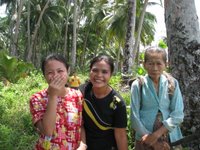
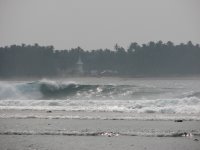 We returned to the house to settle in and meet the family. The house was a simple structure with cement floors, wooden shutters, and a tin roof. To the rear of the house was a garage like attachment that resembled a dark cave. On one side was a cooking area and on the other was a washing area with a well and a bucket and rope tied to it.
We returned to the house to settle in and meet the family. The house was a simple structure with cement floors, wooden shutters, and a tin roof. To the rear of the house was a garage like attachment that resembled a dark cave. On one side was a cooking area and on the other was a washing area with a well and a bucket and rope tied to it.
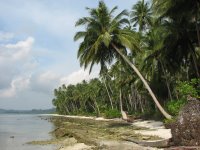 As the sun began to set we put on long pants and shirts, applied mosquito repellant, and lit several mosquito coils on the front porch and in our room. Malaria and dengue Fever are a serious threat on Sumatra’s outer islands and we weren’t taking any chances.
As the sun began to set we put on long pants and shirts, applied mosquito repellant, and lit several mosquito coils on the front porch and in our room. Malaria and dengue Fever are a serious threat on Sumatra’s outer islands and we weren’t taking any chances.
One of the daughters began to light kerosene lanterns, confirming that electricity did not exist on the island. I greeted the oldest daughter and she returned a dirty scowl. I was taken aback by her rudeness, but I soon realized that the 2 sisters had to give up their rooms for us and they were quite bitter about it.
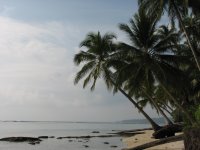
Surf Check

That night we asked the family if we could pay for them to cook for us. They had no food except for rice, so we asked for some boiling water and we ate a feral meal. After we ate we headed strait for the safety of our mozzie nets. Reading with my headlamp I could see about 10 mosquitoes trying to penetrate the net. Without a fan or a sea breeze, it was so hot and humid that our room was a virtual sauna. After a restless night we awoke to the smell of smoke, they crying of babies, and hacking coughs.
There were so many mosquitoes in our room that it was necessary to get dressed under the mosquito net, and get out of the room to the front porch ASAP. After a quick cup of coffee, we would grab our boards and run to the mosquito free zone of the ocean. Breakfast was better attempted after the peak mosquito time at dawn.
 On our second day we decided to hike around the island. As we passed the village storm clouds moved in and a tropical downpour soaked us. About half way around the island we stumbled upon civilization; it was the surf camp. In front of the surf camp was a quality right hand reef that broke on north winds. There we met the two owners, Max and Shane, who invited us in for coffee and Oreo cookies. Inside was a large screen TV with a satellite feed, cold beer, ping pong table, you name it. It was quite odd sitting on a couch watching MTV, such a contrast to our village existence. Max and Shane had just completed the construction of the camp 2 weeks prior, and they had a small group of young pro surfers from Australia there to shoot photos and promote the new camp in the surf mags. Max and Shane were top blokes and we can't thank them enough for their hospitality. Hanging out drinking cold beers with the boys was our reprieve from daily life in the village.
On our second day we decided to hike around the island. As we passed the village storm clouds moved in and a tropical downpour soaked us. About half way around the island we stumbled upon civilization; it was the surf camp. In front of the surf camp was a quality right hand reef that broke on north winds. There we met the two owners, Max and Shane, who invited us in for coffee and Oreo cookies. Inside was a large screen TV with a satellite feed, cold beer, ping pong table, you name it. It was quite odd sitting on a couch watching MTV, such a contrast to our village existence. Max and Shane had just completed the construction of the camp 2 weeks prior, and they had a small group of young pro surfers from Australia there to shoot photos and promote the new camp in the surf mags. Max and Shane were top blokes and we can't thank them enough for their hospitality. Hanging out drinking cold beers with the boys was our reprieve from daily life in the village.
 The Surf
The Surf
As far as the surf went, we couldn't have asked for a better set up. If the wind was southerly, we would surf the left. If the wind was northerly we would walk around the island and surf the right. There were several spots on the surrounding islands that worked in north winds, and when conditions came together we hired Mias to take us there in his small motorized canoe. But unfortunately equatorial Sumatra was having a bad season with the winds. Normally this region is not affected by the normal south easterly trade wind that affects the rest of Indonesia. The winds are normally variable to slack, with the north wind being more predominate.
 But this year was something different altogether with an almost constant southerly flow. Some blamed it on El Nino. Others claimed that the forest fires in Southern Sumatra (uncontrolled burning by farmers and tree plantations) were changing the weather patterns. It was probably a combination of the two, but in the end the winds restricted us to surfing the left almost exclusively. Most days we would have it to ourselves. Other days we awoke to 2 or 3 charter boats anchored in the channel with up to 10 surfers in the water. The south winds were blowing in the Mentawaii Archipelago and this was forcing many of the charter boats to search for waves that could handle the south winds.
But this year was something different altogether with an almost constant southerly flow. Some blamed it on El Nino. Others claimed that the forest fires in Southern Sumatra (uncontrolled burning by farmers and tree plantations) were changing the weather patterns. It was probably a combination of the two, but in the end the winds restricted us to surfing the left almost exclusively. Most days we would have it to ourselves. Other days we awoke to 2 or 3 charter boats anchored in the channel with up to 10 surfers in the water. The south winds were blowing in the Mentawaii Archipelago and this was forcing many of the charter boats to search for waves that could handle the south winds.

Family Living
Sometimes we would hike over to Max and Shane's retreat to hang out in style; cold beers, cable TV, and a cool breeze (such a lifesaver). But most nights would be spent at rumah di Johanas. After dinner we would play a game of domino with Johanas and his son Mias. Sometimes the came would be accompanied by a bottle of Kamput, sweet liquor made from papaya.

Each night, after Adam and I entered the safety of our mozie nets, the family would join together in the front room for the nightly ritual of prayers and songs. We would then try our best to sleep through the heat, often waking up to sheets soaked with sweat. And each sunrise we awoke to hacking coughs, babies crying, and a house filled with smoke. A quick cup of instant coffee while we dodged mosquitoes, and off to the surf we would go.
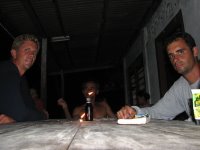
The Feral Chef
I've always considered myself a good cook. Not that I have any recipes written down, I’ve just always had a talent for taking whatever ingredients are available and throwing something together that is tasty and healthy. I believe I learned my techniques through years of camping and cooking on a Coleman stove or on the camp fire. Those camp cooking skills came into play for my biggest culinary challenge to date: Feral Cooking.

We started buying fish and squid and the women folk would cook it for us. The problem was that the women would deep fry everything and cook it to a crisp. It was time for me to take maters in my own hands. We started making trips to Tiduk town which was a 45 minute boat ride. We stocked up on food, warm beer, and a strange papaya liquor called Kamput.
One day I asked the women if I could cook and they reluctantly agreed. Cooking was obviously the realm of women and it seemed as though I was crossing gender lines.
But they stepped aside and let me do my thing. The kitchen was about 6 feet tall with a thatched roof that would allow the smoke to escape (sort of). The cooking area was a cement slab where 3 rocks were set up for the wok to rest on. Using Kerosene, the girls would ignite a small pile of kindling under the wok. After that it was up to me to control the heat by adjusting the amount of wood underneath. The entire kitchen would fill with smoke, so I would sit down or squat to avoid chocking to death. Adam's was assistant feral chef. His job was to pass over the ingredients or utensils (ants would get to the food almost immediately if left on the floor) and swat malarial mosquitoes that would land on my back.
 The women would watch us with curiosity and smiles. It seemed as though we had won their respect and the two sisters would now smile at us and treat us nicely. When we sat on the front porch and prepared our ingredients, the men would watch us with the same curiosity and also amazement at the strange western food we would often prepare. The climax came when Max gave us 6 loaves of bread, 2 blocks of cheddar cheese, and 4 sticks of real French butter (He was shutting down his surf camp for the year). It might sound funny, but the French toast and grilled cheese sandwiches that we created greatly contributed to our survival and sanity on Kalapa Island.
The women would watch us with curiosity and smiles. It seemed as though we had won their respect and the two sisters would now smile at us and treat us nicely. When we sat on the front porch and prepared our ingredients, the men would watch us with the same curiosity and also amazement at the strange western food we would often prepare. The climax came when Max gave us 6 loaves of bread, 2 blocks of cheddar cheese, and 4 sticks of real French butter (He was shutting down his surf camp for the year). It might sound funny, but the French toast and grilled cheese sandwiches that we created greatly contributed to our survival and sanity on Kalapa Island.

Skull Island
One day we decided to explore two islets located of the south eastern tip of the island. We crossed the waist deep, 10 yard channel, at low tide and reached the small coral island covered in dense vegetation. We tromped around looking for bones when Adam screamed, "holy shit!!" A giant lizard sprang from the bushes, darting away from Adam and heading straight for me. My first thought was, "Oh my god it's a Komodo dragon!"
And I practically dove to get out of its way. Within seconds it was
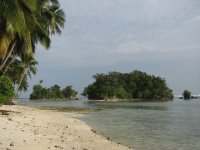
gone. We realized that it was a monitor lizard, which are known to climb up people like a tree, clawing them viciously in the process. Lucky for me I got out of its way.
 After a good search we found piles of bones and several partial skulls. If you looked closely you could see bone fragments practically everywhere. I found a jaw bone with 3 perfect molars still intact and the skull to go along with it. After taking a few photos I was careful to replace the remains exactly as I had found them.
After a good search we found piles of bones and several partial skulls. If you looked closely you could see bone fragments practically everywhere. I found a jaw bone with 3 perfect molars still intact and the skull to go along with it. After taking a few photos I was careful to replace the remains exactly as I had found them.
 According to the islanders, Japanese soldiers used the islet as a mass burial site during World War II. It sounded reasonable, but I wasn't so sure the Japanese had made it to this part of Indonesia. Another possibility was that it was a burial site for a Niasian Noble. In the Niasian culture, craniums were the most valuable things a village could have. When a noble man died, his body was laid out on a bed of craniums. Slaves would guard the dead noble man and the skulls to protect them from neighboring villages. Warring villages would often send warriors to capture craniums
According to the islanders, Japanese soldiers used the islet as a mass burial site during World War II. It sounded reasonable, but I wasn't so sure the Japanese had made it to this part of Indonesia. Another possibility was that it was a burial site for a Niasian Noble. In the Niasian culture, craniums were the most valuable things a village could have. When a noble man died, his body was laid out on a bed of craniums. Slaves would guard the dead noble man and the skulls to protect them from neighboring villages. Warring villages would often send warriors to capture craniums
and hunt for heads.
 The Cave
The Cave
One day when the waves were small we decided to paddle across the channel to the south western corner of Tiduk Island. After reaching the beach we hiked up into the forest where we found the mouth of a cave. Sitting at the mouth of the cave was a small coffin. The coffin was large enough to fit a small child, the wood was very old and the lid was long gone. Looking inside we saw the remains of a small child.
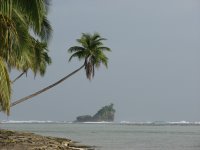
All that was left was the bones of a partial skeleton and the top half of the cranium. Due to the extremely wet environment of the cave, the bones had a green color, the same as the rocks around the coffin. Needless to say it was pretty creepy, we made our way back to the beach and quickly paddled back across the channel.
The Departure
During our last week the southerly winds increased in velocity and we decided it was time to depart. Our decision to leave the majority of our baggage in Nias meant we had to return there on our way to mainland Sumatra. We were in for a tedious journey.
Upon returning to Tiduk Island we ran into our friend Tamarin, a young medical student from England who was finishing up a one month internship at a small medical clinic on the island. There was a public boat that traveled between Tiduk and Nias Islands but with no set schedule. We spent two nights in Tiduk Town until finally the boat arrived one evening. Tamarin was taking five patients to the mainland for treatment and was searching for a boat back to Sumatra. Together we approached the boat captain and offered to charter the boat if he would agree to leave the next day at 10 AM. We worked out a price and shook hands, but in Indonesia, there’s always some sort of drama.
The next morning the boat was prepared to leave on time, but it wasn’t a charter, it was open to the public. So basically our group was being forced to pay four times the amount of a normal ticket. Tamarin is a strong woman and she wasn’t about to get ripped off. Adam and I didn’t want the drama and were willing to pay the Bule price, but Tamarin refused. After 15 minutes of intense negotiation, the captain backed down and Tamarin prevailed. I was impressed to say the least.
On Kalapa Island, if you have baby teeth,
they are rotten. Most famlies can't afford
toothpaste.
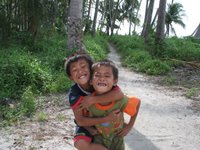
Tamarin’s patients brought to light the dire situation of the people in outer island Sumatra. Basic health care is hard to come by, and the average life expectancy of the people is 50 years. If someone is afflicted by serious disease, without the money or resources t seek treatment, many just accept it as fate. There was a young girl who had suffered 3rd degree burns on her arm and cried the entire way and a boy who had a cancerous tumor growing out of the side of his face. I thought about the plight of these people and how we in the western world take for granted things like basic medical care.
We arrived back to Teluk Delam, and rode on top of a bus back to Nias. The next morning we awoke to small surf and poor conditions. We teamed up with some south Africans and took a bemo to the north end of the island, making it onto the ferry bound for Sumatra with only minutes to spare.
Oh the smell of copra in the morning.
One of the natural resources of tropical
Asia, coconut is smoked and shipped off
to make coconut oil.


The Island of Nias got smaller and smaller until it finally sank beneath the waves in the horizon. The seas were rough and the clouds threatened a down pour but soon cleared and the sun shone down on us as we lay accross the front deck.

We dozed off and awoke to the smell of Mahi Mahi and our bellies began to rumble. We asked the boats cook for some hot water and selected two feral meals (freeze-dried backpacker food), beef patties with mash potatoes being the prime choice. The smokey beef patties were a little taste of heaven, a reminder of the comforts of home.





After roughly 5 hours at sea, the sun began to fade and we got our first glance of the Tiduk Archipelago far in the horizon. Garbage began to appear in the water and we knew that we were close to Indonesian civilization.

A pod of dolphins appeared and playfully swam in the wake of our boat. As we approached the first island with the last trace of light, we could make out a small but nice left breaking off a forest covered point, locals fishing the inner lagoon in their small canoes.


We pulled into Tiduk Island, the administrative island of the archipelago, under a sheet of darkness. In the Tiduk town harbor we docked against another fishing vessel and carried our luggage over three boats before we reached solid ground. Lucky for us, our hotel was right there; we threw our stuff in the room and headed out to get some food.
One of the only 3 cars on Tiduk Island.

Tiduk Town was like a paradise compared to Teluk Delam in Nias. The people were much friendlier than those in Nias, maybe due to the fact travelers are still something of a novelty. The streets were neat and tidy, and we devoured our best meal in weeks at a super nice family run Padang restaurant.

The next day we woke up early to make our way to a small Island to the south where we would spend our next 3 weeks. Kalapa was an island about the size of Alcatraz Island, having a small one lane road circling its coastline. Since the whole island had maybe 3 automobiles, most people got around by Becak (Peddle powered tricycles) or motoscooters. We negotiated 2 becaks to take us to the southern end of the island with all our gear.


On the ride south we passed village after small village and at least 100 "hello misters" along the way. The people of this archipelago are ethnic Niasians, and each village had its traditional stone gateway and village courtyard. Soon the villages ended as we continued on through tropical forest, finally reaching a small primary school at the southern end of the Island.


 Our luck must have been on because we arrived right in time for recess. A hundred children in the Indonesian red and white school uniform ran over screaming "tourist!" and the infamous "hello mister!”. One of the teachers spoke English and I explained that I was a teacher back home. He translated this to the female teachers in the office who gave me smiles and nods of approval.
Our luck must have been on because we arrived right in time for recess. A hundred children in the Indonesian red and white school uniform ran over screaming "tourist!" and the infamous "hello mister!”. One of the teachers spoke English and I explained that I was a teacher back home. He translated this to the female teachers in the office who gave me smiles and nods of approval. We negotiated a small canoe to take us across the small channel separating Tiduk and Kalapa Island, about 400 yards across. The canoe was VERY small and shallow, yet both of the Indonesian men insisted on coming with. With 4 men, 2 full size surfboard bags, backpacks, and thousands of dollars in camera gear, the top of the canoe rose only an inch above the water. I tried to explain that one of them should get out, but it was no use; we were already a quarter of the way there. Luckily there was no swell in the channel, but the wind chop was starting to fill the boat with water.
We negotiated a small canoe to take us across the small channel separating Tiduk and Kalapa Island, about 400 yards across. The canoe was VERY small and shallow, yet both of the Indonesian men insisted on coming with. With 4 men, 2 full size surfboard bags, backpacks, and thousands of dollars in camera gear, the top of the canoe rose only an inch above the water. I tried to explain that one of them should get out, but it was no use; we were already a quarter of the way there. Luckily there was no swell in the channel, but the wind chop was starting to fill the boat with water.You can paddle across the channel
in about 10 minutes.

I was freaking, but the two Indo men were not at all concerned. I quickly pulled out my trusty leathermen to make a bailer out of a water bottle. We continued to bail out water until we reached the other side.
When we reached Kalapa Island we found three simple houses on the beach on the north end. We walked straight up to the first house and asked the man of the house, Johanas, if he knew of any families on the island that we could stay with. He told us that he would rent us a room in his house for the equivalent of $3 per person. We began to haggle the price but the price was final and Johanas was going to have none of it. We agreed, and the women of the house began to clean out the room.
 The first thing we did was grab our boards and search for the wave we had read about. After 10 minutes of walking on a small trail that runs along the beach and circles the island we reached the main village. Out in front of the church appeared to be the setup. There was no one out but we decided to give it a go. After about 10 minutes of surfing by ourselves, a boat pulled up out of nowhere and four surfers joined us. We came to find out that they were from the new surf camp somewhere in the vicinity.
The first thing we did was grab our boards and search for the wave we had read about. After 10 minutes of walking on a small trail that runs along the beach and circles the island we reached the main village. Out in front of the church appeared to be the setup. There was no one out but we decided to give it a go. After about 10 minutes of surfing by ourselves, a boat pulled up out of nowhere and four surfers joined us. We came to find out that they were from the new surf camp somewhere in the vicinity.
 We returned to the house to settle in and meet the family. The house was a simple structure with cement floors, wooden shutters, and a tin roof. To the rear of the house was a garage like attachment that resembled a dark cave. On one side was a cooking area and on the other was a washing area with a well and a bucket and rope tied to it.
We returned to the house to settle in and meet the family. The house was a simple structure with cement floors, wooden shutters, and a tin roof. To the rear of the house was a garage like attachment that resembled a dark cave. On one side was a cooking area and on the other was a washing area with a well and a bucket and rope tied to it. As the sun began to set we put on long pants and shirts, applied mosquito repellant, and lit several mosquito coils on the front porch and in our room. Malaria and dengue Fever are a serious threat on Sumatra’s outer islands and we weren’t taking any chances.
As the sun began to set we put on long pants and shirts, applied mosquito repellant, and lit several mosquito coils on the front porch and in our room. Malaria and dengue Fever are a serious threat on Sumatra’s outer islands and we weren’t taking any chances.One of the daughters began to light kerosene lanterns, confirming that electricity did not exist on the island. I greeted the oldest daughter and she returned a dirty scowl. I was taken aback by her rudeness, but I soon realized that the 2 sisters had to give up their rooms for us and they were quite bitter about it.

Surf Check

That night we asked the family if we could pay for them to cook for us. They had no food except for rice, so we asked for some boiling water and we ate a feral meal. After we ate we headed strait for the safety of our mozzie nets. Reading with my headlamp I could see about 10 mosquitoes trying to penetrate the net. Without a fan or a sea breeze, it was so hot and humid that our room was a virtual sauna. After a restless night we awoke to the smell of smoke, they crying of babies, and hacking coughs.
There were so many mosquitoes in our room that it was necessary to get dressed under the mosquito net, and get out of the room to the front porch ASAP. After a quick cup of coffee, we would grab our boards and run to the mosquito free zone of the ocean. Breakfast was better attempted after the peak mosquito time at dawn.
 On our second day we decided to hike around the island. As we passed the village storm clouds moved in and a tropical downpour soaked us. About half way around the island we stumbled upon civilization; it was the surf camp. In front of the surf camp was a quality right hand reef that broke on north winds. There we met the two owners, Max and Shane, who invited us in for coffee and Oreo cookies. Inside was a large screen TV with a satellite feed, cold beer, ping pong table, you name it. It was quite odd sitting on a couch watching MTV, such a contrast to our village existence. Max and Shane had just completed the construction of the camp 2 weeks prior, and they had a small group of young pro surfers from Australia there to shoot photos and promote the new camp in the surf mags. Max and Shane were top blokes and we can't thank them enough for their hospitality. Hanging out drinking cold beers with the boys was our reprieve from daily life in the village.
On our second day we decided to hike around the island. As we passed the village storm clouds moved in and a tropical downpour soaked us. About half way around the island we stumbled upon civilization; it was the surf camp. In front of the surf camp was a quality right hand reef that broke on north winds. There we met the two owners, Max and Shane, who invited us in for coffee and Oreo cookies. Inside was a large screen TV with a satellite feed, cold beer, ping pong table, you name it. It was quite odd sitting on a couch watching MTV, such a contrast to our village existence. Max and Shane had just completed the construction of the camp 2 weeks prior, and they had a small group of young pro surfers from Australia there to shoot photos and promote the new camp in the surf mags. Max and Shane were top blokes and we can't thank them enough for their hospitality. Hanging out drinking cold beers with the boys was our reprieve from daily life in the village. The Surf
The SurfAs far as the surf went, we couldn't have asked for a better set up. If the wind was southerly, we would surf the left. If the wind was northerly we would walk around the island and surf the right. There were several spots on the surrounding islands that worked in north winds, and when conditions came together we hired Mias to take us there in his small motorized canoe. But unfortunately equatorial Sumatra was having a bad season with the winds. Normally this region is not affected by the normal south easterly trade wind that affects the rest of Indonesia. The winds are normally variable to slack, with the north wind being more predominate.
 But this year was something different altogether with an almost constant southerly flow. Some blamed it on El Nino. Others claimed that the forest fires in Southern Sumatra (uncontrolled burning by farmers and tree plantations) were changing the weather patterns. It was probably a combination of the two, but in the end the winds restricted us to surfing the left almost exclusively. Most days we would have it to ourselves. Other days we awoke to 2 or 3 charter boats anchored in the channel with up to 10 surfers in the water. The south winds were blowing in the Mentawaii Archipelago and this was forcing many of the charter boats to search for waves that could handle the south winds.
But this year was something different altogether with an almost constant southerly flow. Some blamed it on El Nino. Others claimed that the forest fires in Southern Sumatra (uncontrolled burning by farmers and tree plantations) were changing the weather patterns. It was probably a combination of the two, but in the end the winds restricted us to surfing the left almost exclusively. Most days we would have it to ourselves. Other days we awoke to 2 or 3 charter boats anchored in the channel with up to 10 surfers in the water. The south winds were blowing in the Mentawaii Archipelago and this was forcing many of the charter boats to search for waves that could handle the south winds.
Family Living
Sometimes we would hike over to Max and Shane's retreat to hang out in style; cold beers, cable TV, and a cool breeze (such a lifesaver). But most nights would be spent at rumah di Johanas. After dinner we would play a game of domino with Johanas and his son Mias. Sometimes the came would be accompanied by a bottle of Kamput, sweet liquor made from papaya.

Each night, after Adam and I entered the safety of our mozie nets, the family would join together in the front room for the nightly ritual of prayers and songs. We would then try our best to sleep through the heat, often waking up to sheets soaked with sweat. And each sunrise we awoke to hacking coughs, babies crying, and a house filled with smoke. A quick cup of instant coffee while we dodged mosquitoes, and off to the surf we would go.

The Feral Chef
I've always considered myself a good cook. Not that I have any recipes written down, I’ve just always had a talent for taking whatever ingredients are available and throwing something together that is tasty and healthy. I believe I learned my techniques through years of camping and cooking on a Coleman stove or on the camp fire. Those camp cooking skills came into play for my biggest culinary challenge to date: Feral Cooking.

We started buying fish and squid and the women folk would cook it for us. The problem was that the women would deep fry everything and cook it to a crisp. It was time for me to take maters in my own hands. We started making trips to Tiduk town which was a 45 minute boat ride. We stocked up on food, warm beer, and a strange papaya liquor called Kamput.
One day I asked the women if I could cook and they reluctantly agreed. Cooking was obviously the realm of women and it seemed as though I was crossing gender lines.
But they stepped aside and let me do my thing. The kitchen was about 6 feet tall with a thatched roof that would allow the smoke to escape (sort of). The cooking area was a cement slab where 3 rocks were set up for the wok to rest on. Using Kerosene, the girls would ignite a small pile of kindling under the wok. After that it was up to me to control the heat by adjusting the amount of wood underneath. The entire kitchen would fill with smoke, so I would sit down or squat to avoid chocking to death. Adam's was assistant feral chef. His job was to pass over the ingredients or utensils (ants would get to the food almost immediately if left on the floor) and swat malarial mosquitoes that would land on my back.
 The women would watch us with curiosity and smiles. It seemed as though we had won their respect and the two sisters would now smile at us and treat us nicely. When we sat on the front porch and prepared our ingredients, the men would watch us with the same curiosity and also amazement at the strange western food we would often prepare. The climax came when Max gave us 6 loaves of bread, 2 blocks of cheddar cheese, and 4 sticks of real French butter (He was shutting down his surf camp for the year). It might sound funny, but the French toast and grilled cheese sandwiches that we created greatly contributed to our survival and sanity on Kalapa Island.
The women would watch us with curiosity and smiles. It seemed as though we had won their respect and the two sisters would now smile at us and treat us nicely. When we sat on the front porch and prepared our ingredients, the men would watch us with the same curiosity and also amazement at the strange western food we would often prepare. The climax came when Max gave us 6 loaves of bread, 2 blocks of cheddar cheese, and 4 sticks of real French butter (He was shutting down his surf camp for the year). It might sound funny, but the French toast and grilled cheese sandwiches that we created greatly contributed to our survival and sanity on Kalapa Island.
Skull Island
One day we decided to explore two islets located of the south eastern tip of the island. We crossed the waist deep, 10 yard channel, at low tide and reached the small coral island covered in dense vegetation. We tromped around looking for bones when Adam screamed, "holy shit!!" A giant lizard sprang from the bushes, darting away from Adam and heading straight for me. My first thought was, "Oh my god it's a Komodo dragon!"
And I practically dove to get out of its way. Within seconds it was

gone. We realized that it was a monitor lizard, which are known to climb up people like a tree, clawing them viciously in the process. Lucky for me I got out of its way.
 After a good search we found piles of bones and several partial skulls. If you looked closely you could see bone fragments practically everywhere. I found a jaw bone with 3 perfect molars still intact and the skull to go along with it. After taking a few photos I was careful to replace the remains exactly as I had found them.
After a good search we found piles of bones and several partial skulls. If you looked closely you could see bone fragments practically everywhere. I found a jaw bone with 3 perfect molars still intact and the skull to go along with it. After taking a few photos I was careful to replace the remains exactly as I had found them. According to the islanders, Japanese soldiers used the islet as a mass burial site during World War II. It sounded reasonable, but I wasn't so sure the Japanese had made it to this part of Indonesia. Another possibility was that it was a burial site for a Niasian Noble. In the Niasian culture, craniums were the most valuable things a village could have. When a noble man died, his body was laid out on a bed of craniums. Slaves would guard the dead noble man and the skulls to protect them from neighboring villages. Warring villages would often send warriors to capture craniums
According to the islanders, Japanese soldiers used the islet as a mass burial site during World War II. It sounded reasonable, but I wasn't so sure the Japanese had made it to this part of Indonesia. Another possibility was that it was a burial site for a Niasian Noble. In the Niasian culture, craniums were the most valuable things a village could have. When a noble man died, his body was laid out on a bed of craniums. Slaves would guard the dead noble man and the skulls to protect them from neighboring villages. Warring villages would often send warriors to capture craniumsand hunt for heads.
 The Cave
The CaveOne day when the waves were small we decided to paddle across the channel to the south western corner of Tiduk Island. After reaching the beach we hiked up into the forest where we found the mouth of a cave. Sitting at the mouth of the cave was a small coffin. The coffin was large enough to fit a small child, the wood was very old and the lid was long gone. Looking inside we saw the remains of a small child.

All that was left was the bones of a partial skeleton and the top half of the cranium. Due to the extremely wet environment of the cave, the bones had a green color, the same as the rocks around the coffin. Needless to say it was pretty creepy, we made our way back to the beach and quickly paddled back across the channel.
The Departure
During our last week the southerly winds increased in velocity and we decided it was time to depart. Our decision to leave the majority of our baggage in Nias meant we had to return there on our way to mainland Sumatra. We were in for a tedious journey.
Upon returning to Tiduk Island we ran into our friend Tamarin, a young medical student from England who was finishing up a one month internship at a small medical clinic on the island. There was a public boat that traveled between Tiduk and Nias Islands but with no set schedule. We spent two nights in Tiduk Town until finally the boat arrived one evening. Tamarin was taking five patients to the mainland for treatment and was searching for a boat back to Sumatra. Together we approached the boat captain and offered to charter the boat if he would agree to leave the next day at 10 AM. We worked out a price and shook hands, but in Indonesia, there’s always some sort of drama.
The next morning the boat was prepared to leave on time, but it wasn’t a charter, it was open to the public. So basically our group was being forced to pay four times the amount of a normal ticket. Tamarin is a strong woman and she wasn’t about to get ripped off. Adam and I didn’t want the drama and were willing to pay the Bule price, but Tamarin refused. After 15 minutes of intense negotiation, the captain backed down and Tamarin prevailed. I was impressed to say the least.
On Kalapa Island, if you have baby teeth,
they are rotten. Most famlies can't afford
toothpaste.

Tamarin’s patients brought to light the dire situation of the people in outer island Sumatra. Basic health care is hard to come by, and the average life expectancy of the people is 50 years. If someone is afflicted by serious disease, without the money or resources t seek treatment, many just accept it as fate. There was a young girl who had suffered 3rd degree burns on her arm and cried the entire way and a boy who had a cancerous tumor growing out of the side of his face. I thought about the plight of these people and how we in the western world take for granted things like basic medical care.
We arrived back to Teluk Delam, and rode on top of a bus back to Nias. The next morning we awoke to small surf and poor conditions. We teamed up with some south Africans and took a bemo to the north end of the island, making it onto the ferry bound for Sumatra with only minutes to spare.
Oh the smell of copra in the morning.
One of the natural resources of tropical
Asia, coconut is smoked and shipped off
to make coconut oil.



1 Comments:
Rockin' the Concussion foamie on Skull Island! Classic.
Post a Comment
<< Home